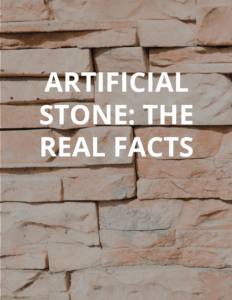 Architects and general contractors are constantly looking for ways to reduce construction costs of new homes. One area where many of them cut costs is on the exterior façade of the home. This is why we see so much artificial (or synthetic) stone being used today. However, when choosing between natural stone and the man-made knockoff, it is important to consider all the facts – not just the initial cost.
Architects and general contractors are constantly looking for ways to reduce construction costs of new homes. One area where many of them cut costs is on the exterior façade of the home. This is why we see so much artificial (or synthetic) stone being used today. However, when choosing between natural stone and the man-made knockoff, it is important to consider all the facts – not just the initial cost.
One of the most obvious drawbacks to artificial stone is its durability – or lack thereof. Man-made stone is simply not as durable as the real thing. Artificial stone is made from a lightweight concrete mixture that can often break or chip. When this happens, it is usually quite noticeable. Many manufacturers of this product do not color their concrete through and through. As such, when a piece of artificial stone is cut or broken, exposing the interior, it is obvious to even the most untrained eye that this material is made from concrete. Unlike artificial stone products, natural stone is colorfast and resists scratching and fading. When a piece of natural stone is cut or broken, it simply exposes more natural stone. Moreover, because synthetic stone is cast in a limited number of molds, the larger the area covered, the more repetitive the pattern becomes, making it obvious that the material is fake. Also, in some climate conditions, synthetic stone can shrink or expand over time, causing cracks and mortar gaps. Due to high moisture absorption characteristics, fake stone should not be installed all the way down to the ground. This can create an unattractive appearance and highlight the fact that the material is not real.
Another common drawback to artificial stone is found in the installation process. Manufacturers of man-made stone commonly tout the ease of installation of their product. On the surface, this sounds as if it would be a desirable characteristic. However, an unintended consequence of this claim is that, oftentimes, contractors with little or no masonry experience are installing the product. In contrast, a reputable natural stone producer would never suggest that natural stone should be installed on the façade of a home by anyone other than a qualified mason.
When installed improperly, synthetic stone can trap moisture, causing severe damage to the sheathing and structural framing of the home. This problem is becoming more evident as time goes by and is similar to the problems experienced with EIFS (synthetic stucco) in the late 90’s. This growing problem is becoming so prevalent that many articles and videos have been issued by industry associations and trade publications. Following are links to archived copies of just a few of these articles:
- Cultured Stone Cladding – The Truth
YouTube Video Published by HouseInvestigations.com - How to Destroy a Wall in Two Easy Steps
Published by The Journal of Light Construction - A Manufactured Stone Installation That’s Doomed to Eventual Failure
Published by FineHomebuilding - Adhered Concrete Masonry Veneer – The Next Big Problem in Construction
Published by ABI Home Inspections - Rampant Installation Problems with Artificial Stone Siding
Published by The Star Tribune - Cultured Stone Update 2011
Published by Dillon Residential Services, Inc. - Rescuing a Manufactured Stone Wall
Published by The Journal of Light Construction - Manufactured Stone Nightmares
Published by The Journal of Light Construction
If this problem continues to escalate, it is possible that the existence of fake stone may decrease the value of your home in the future or, worse yet, make it nearly impossible to resell.
Another aspect to consider is the environmental impact of using a cement-based product over natural stone. Concrete products contain the highest levels of embodied energy of all building materials. What this means is that the processes used to produce concrete requires great amounts of energy. The manufacturing process creates very high levels of carbon emissions with temperatures reaching 2,000 degrees Celsius. The process also releases high levels of carbon dioxide into the environment. In total about 7% of global CO2 emissions come from concrete production. Conversely, natural stone is a naturally green building material. It is moisture resistant and lasts a lifetime. And unlike synthetic stone, natural stone can be recycled.
One last thing to consider is warranties. We have heard a lot about the long-term warranties heralded by the manufacturers of fake stone. But if you read the fine print, most of those warranties are full of exclusions and ambiguous language that favors the manufacturer much more than the end user. One of the most blatant examples we have found is the exclusion for “discoloration due to airborne contaminants”. A frequent complaint about man-made stone is the fading of colors over time. But good luck proving that this is not caused by “airborne contaminants”. Natural stone, on the other hand, tends to fade or discolor less than synthetic stone. Even if it does fade somewhat, it tends to add to the natural characteristics of the stone itself – instead of exposing an interior made of concrete.
In closing, though artificial stone is a good alternative for use in some situations, it is very important to consider the true costs of using a fake material over a real natural stone product. It is always wise to stretch your construction dollars as far as they will go. But sometimes saving a little money now can cost you a lot more in the long run. If you do your homework and compare every aspect of the two products, we think you will find that natural stone will always give you the best overall return on your investment.



